Cockfighting in Upriver Sarawak: E-Gov Makes Things (not quite) Easier
 Apai Regang is expected to download a permit in PDF form if he wants to see his cock fight
Apai Regang is expected to download a permit in PDF form if he wants to see his cock fight E-MALAYSIA
When former Prime Minister Dr. Mahathir Mohamad urgently called for Malaysia's cyber-wiring back in 1996, the entire nation was dragged into an obsessive hi-tech internet craze, spearheaded by such Orwellian-sounding megaprojects like 'Cyberjaya', 'Malaysia Multimedia Super-Corridor', 'Technopreneur Development', 'Smart Schools', 'E-Bario Project'. E-Gov.
In line with Dr. M's national call to get cyber-wired, the Malaysian government urged State governments to set-up e-gov (electronic government) websites all the way down to Resident and District Offices to improve efficiency of information dissemination, governance and public services. And yes, this call even resonated down to the deep verdant jungles of East Malaysia's Borneo States of Sarawak and Sabah. (we'll return to this e-gov thing in a moment)
Kapit Division in Sarawak is a predominantly rural and forested area, inhabited by numerous ethnic groups that still practice swidden (incorrectly called 'slash-and-burn') agriculture, among which the Dayak Iban constitute a significant majority. The majority of Ibans reside in traditional longhouses along the banks of the Batang Rejang and Balleh rivers , and while there has been a longstanding trend of urbanisation from upriver longhouses to major cities, Iban traditions are still well-kept in place.
 Map Kapit Division in Sarawak
Map Kapit Division in SarawakTHE IBANS OF SARAWAK
Known in the past for being land-hungry, independent and ferocious headhunters, the Ibans had to be painstakingly subjugated under strict rulings by successive Sarawak governments ever since the arrival of Sir James Brooke, the first White Rajah of Sarawak, back in 1841. After Iban inter-tribal warfare and headhunting were finally laid to rest in 1924, 'Iban problems' were far from over. The Brooke government was subsequently plagued by efforts in preventing Ibans from migrating northwards in search for better economic opportunities offered by the discovery of oil reserves in Miri and Brunei. One major problem was the oft-resulting land disputes among Ibans and communities in their new destinations. For this, the Brooke government had to enforce numerous regulations to prevent Ibans from out migrating from their very homelands around Kapit, and Ibans were required well into the 1960s to carry travel permits wherever they intended to go, even within Sarawak.
Other restrictions placed upon Ibans since the Brooke period was related to gambling, often the result of debt problems between Ibans and Chinese traders - or the main cause of personal vendettas that often resulted in brawls and homicides. What has been difficult for successive governments to keep in check, however, was gambling in the guise of cockfight gatherings during traditional Iban celebrations such as Gawai (harvest feast) or death ceremonies. Hence, Ibans were for a longtime required to apply for 'Cockfight Permits' (Lesen Sabong Ayam) from the Kapit Resident Office.
While travel permit requirements for Ibans were lifted more than 40 years ago, Cockfight Permits made it well into the age of cyberspace...
COCKFIGHT PERMITS ? DOWNLOAD IT...
The e-gov website of the Kapit Resident's office is a fancy and well-designed homepage (its sister-website owned by the Kapit District Council even requires you to have a Flash plugin!), complete with information for tourists, as well as downloadable government forms for locals in PDF format. (i.e., Marriage Application forms, Business licence applications, etc.). This includes the Cockfight Permit.
Download Cockfight Permit ('Lesen Sabong Ayam'):
http://www.kapitro.sarawak.gov.my/php/main/english/kapitro/pdf/cock-fighting.pdf
Here's the catch. Since cockfighting throughout the Kapit Division is a predominantly Iban cultural practice, the website's administrator surely must have uploaded the forms anticipating masses of Iban downloaders in mind.
Now consider this:
- None of the Iban longhouses throughout the Division enjoys telephone, let alone internet connection.
- There's only one internet cafe throughout the Division, so it would cost an Iban (if he's a computer-literate) RM 2.30 to obtain and print a cockfight permit (RM 2.00 minimum internet time + 30 cents for printing two pages).
- This internet cafe is located by coincidence next to the Resident's Office in Kapit where, ironically, hardcopies of Cockfight Permits can be obtained for FREE.
But again, it takes 3 to 5 hours by river for an ordinary upriver Iban to reach Kapit town - so it would take him at least one full day back-and-forth just to obtain (download?) the permit application. He then has to return to his longhouse upriver to have this application signed by the longhouse leader (Tuai Rumah), plus another trip to hand in the filled application to the Resident. This all would cost an Iban 2 days travelling time back-and-forth and at least RM 100 for travel costs.
A single cockfight rarely lasts longer than 3 minutes, so would anyone expect Ibans to care about these permits at all?

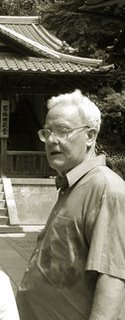



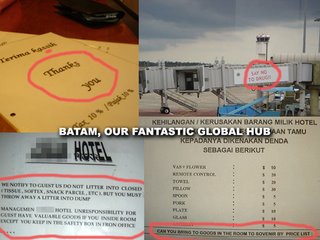 Global, not quite...
Global, not quite... Hang Nadim Airport: Counter for Job Seekers. Is the system running at all?
Hang Nadim Airport: Counter for Job Seekers. Is the system running at all? A peek outside the hotel: Disposed tissues, cigarette packs, condoms. Helps in profiling your average Batam visitor...
A peek outside the hotel: Disposed tissues, cigarette packs, condoms. Helps in profiling your average Batam visitor...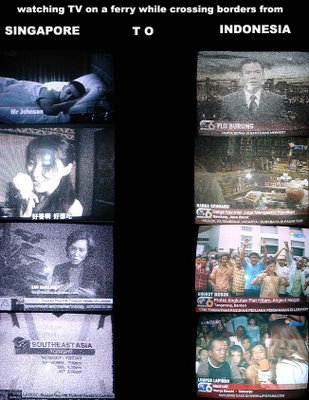
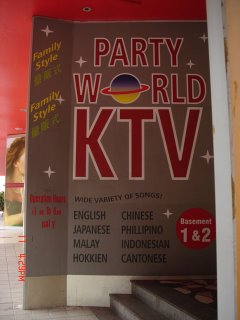
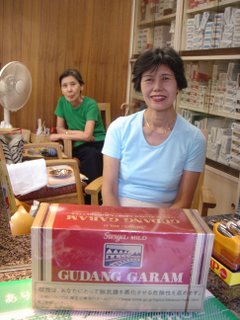 Gudang Garamu Mairudo
Gudang Garamu Mairudo